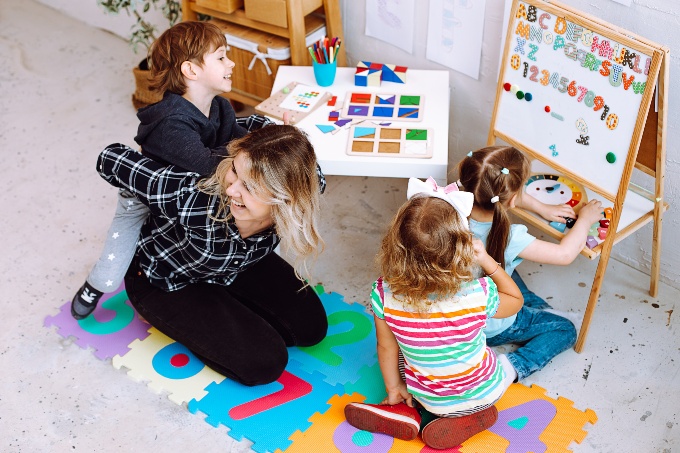Language development during early childhood is critical to a child’s overall growth. It’s not just about learning to speak but also about understanding and being understood. Parents, educators, and caregivers are pivotal in this developmental phase. The techniques and activities employed can significantly impact how effectively a child learns and uses language.
A remarkable example of effective language development practices is in children’s centers, where a blend of play-based learning and structured language activities fosters robust language skills in young children. This approach exemplifies the balance needed in early childhood language development.
Encouraging Language Through Play
Play is an essential and delightful way for children to learn. As children engage in different forms of play, they explore their environment and develop vital language skills. Interactive games like role-playing allow children to immerse themselves in various scenarios, practicing and experimenting with language in an imaginative and safe context. This play often involves problem-solving, negotiation, and storytelling, contributing to language development.
Group play is crucial for developing social language skills, especially with peers. It teaches children to take turns, listen to others, and express their ideas. During group play, children are exposed to a diverse range of vocabulary and sentence structures as they interact with others who speak differently. This exposure is invaluable in teaching them the nuances of language and effective communication. Enrolling your child in children’s centers like Brookvale Children’s Centre will surely guarantee that they experience a fun but productive learning environment.

Reading And Storytelling: A Gateway To Language
Reading and storytelling are powerful tools for developing language skills in early childhood. Regular reading sessions expose children to vocabulary, sentence structures, and linguistic concepts. Choosing a range of books, including those that challenge the child’s current language level, is important.
When reading to a child, it’s beneficial to use different voices for characters, emphasize keywords, and vary your tone to maintain their interest. This makes the experience more engaging and helps children understand the emotional context of words and sentences. Additionally, asking open-ended questions about the story can stimulate critical thinking and encourage children to express themselves, enhancing their language skills.
Music And Songs: Rhythm In Language Learning
Music and songs are more than just entertainment; they are effective tools for language learning. The repetitive nature of songs makes it easier for children to learn and remember new words and phrases. Additionally, the rhythm and melody of songs aid in retaining linguistic structures.
Incorporating music into daily routines can make learning more enjoyable. For example, songs about daily activities like getting dressed or cleaning up can make these tasks fun and provide opportunities to learn new vocabulary. Sing-along sessions can also boost confidence in using language and help with pronunciation and rhythm in speech.
Art And Language: Expressing Through Creativity
Art provides a unique medium for children to express their thoughts and develop language skills. While engaging in art, children often describe what they are creating, use adjectives to explain colors and shapes, and tell stories about their artwork. This process enriches their vocabulary and enhances their ability to construct narratives.
Art can also be used to reinforce language concepts. For example, after reading a story, a child can draw a scene from it, which provides an opportunity to discuss and reinforce the vocabulary and themes from the story. This visual representation of language concepts can help solidify their understanding.
Technology-Assisted Language Learning
In the digital age, technology offers new avenues for language development. Educational apps and games designed for young children can introduce new words and concepts in a highly engaging and interactive manner. These tools often use animations, sounds, and interactive activities to make language learning appealing and fun.
It’s essential to select age-appropriate and educationally valuable digital content. Interactive e-books, language learning apps, and educational games can be integrated into a child’s learning routine. However, balancing technology use with traditional learning methods and real-world interactions is important to ensure a holistic language learning experience.
Parental Involvement: A Key Factor
The role of parents in language development cannot be overstated. Regular, meaningful conversations between a parent and child are fundamental in developing the child’s language skills. Discuss everyday activities, ask open-ended questions, and encourage them to describe their experiences and feelings.
This ongoing dialogue helps build vocabulary and sentence structure and understand the nuances of language, such as tone and non-verbal cues. Parents can also provide corrections and feedback in a supportive way, helping children refine their language skills in a natural and comfortable environment.
Conclusion
Effective language development in early childhood requires a mix of play, reading, music, art, technology, and, most importantly, parental involvement. Each of these elements uniquely contributes to a child’s linguistic growth. As caregivers and educators, creating a nurturing and stimulating environment where children can explore and develop their language skills naturally and joyfully is essential. Remember, every word spoken or sung, every story told, and every conversation built the foundation for a child’s future communication abilities.
